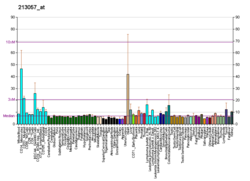Top Qs
Timeline
Chat
Perspective
ATPAF2
Protein-coding gene in the species Homo sapiens From Wikipedia, the free encyclopedia
Remove ads
ATP synthase mitochondrial F1 complex assembly factor 2 is an enzyme that in humans is encoded by the ATPAF2 gene.[5][6][7]
This gene encodes an assembly factor for the F(1) component of the mitochondrial ATP synthase. This protein binds specifically to the F1 alpha subunit and is thought to prevent the subunit from forming nonproductive homooligomers during enzyme assembly. This gene is located within the Smith–Magenis syndrome region on chromosome 17. An alternatively spliced transcript variant has been described, but its biological validity has not been determined.[7] A mutation in this gene has caused nuclear type 1 Complex V deficiency, characterized by lactic acidosis, encephalopathy, and developmental delays.[8][9]
Remove ads
Structure
The ATPAF2 gene is located on the p arm of chromosome 17 in position 11.2 and spans 24,110 base pairs.[7] The gene produces a 32.8 kDa protein composed of 289 amino acids.[10][11] This gene has at least 8 exons and is located within the Smith-Magenis syndrome region on chromosome 17.[7]
Function
The ATPAF2 gene encodes an essential housekeeping protein, an assembly factor for the F1 component of mitochondrial ATP synthase. This protein binds specifically to the F1 alpha subunit and is thought to prevent this subunit from forming nonproductive homooligomers during enzyme assembly.[5][7]
Clinical significance
In the only report of a mutation in the ATPAF2 gene, the resulting phenotype was nuclear type 1 Complex V deficiency inherited in an autosomal recessive manner. A homozygous 280T-A transversion caused a W94R amino acid substitution adjacent to a highly conserved glutamine. Symptoms included elevated blood, CSF, and urine lactate levels, developmental delays with failure to thrive and seizures, and a degenerative encephalopathy with cortical and subcortical atrophy.[8][9]
Interactions
The encoded protein interacts with ATP5F1A and FMC1, along with many other proteins.[5][12][13]
References
Further reading
External links
Wikiwand - on
Seamless Wikipedia browsing. On steroids.
Remove ads





